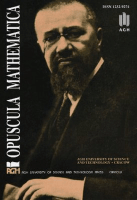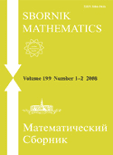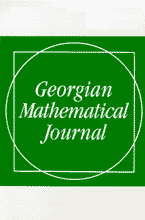
Analysis in Theory and Applications
Scope & Guideline
Cultivating Knowledge in Interdisciplinary Analysis
Introduction
Aims and Scopes
- Mathematical Analysis:
The journal emphasizes rigorous mathematical analysis, exploring topics such as functional analysis, harmonic analysis, and operator theory. - Partial Differential Equations (PDEs):
A significant focus is placed on the study of partial differential equations, including existence, uniqueness, and regularity results for various classes of PDEs. - Approximation Theory:
Research in approximation theory, including interpolation and approximation by various mathematical operators, is a core area of investigation. - Nonlinear Analysis:
The journal publishes studies on nonlinear phenomena, particularly solutions to nonlinear equations and systems, including variational methods. - Harmonic Analysis and Operator Theory:
There is a notable focus on harmonic analysis, including singular integrals and boundedness of operators, particularly in weighted spaces. - Applications in Mathematical Physics:
The journal also highlights applications of analysis in mathematical physics, including studies on Schrödinger equations and dynamical systems.
Trending and Emerging
- Fractional Calculus and Differential Equations:
Recent papers indicate a growing interest in fractional calculus, particularly in the context of differential equations, highlighting its applications in various scientific fields. - Neural Networks and Machine Learning Techniques:
There is an increasing trend towards utilizing neural networks for approximation and functional analysis, showcasing the intersection of modern computational methods with traditional analysis. - Nonlinear Dynamics and Complex Systems:
Research on nonlinear dynamics, including chaotic systems and bifurcation theory, has gained traction, reflecting broader interests in complex systems behavior. - Weighted Norm Inequalities:
A significant number of recent studies focus on weighted norm inequalities, emphasizing their importance in both theoretical and practical applications of analysis. - Existence and Multiplicity of Solutions:
There is a notable increase in research dedicated to the existence and multiplicity of solutions for various equations, particularly in nonlinear contexts, underscoring the relevance of variational methods.
Declining or Waning
- Classical Functional Spaces:
Research on classical functional spaces such as Banach and Hilbert spaces appears to be declining, as newer studies focus more on generalized or weighted spaces. - Basic Integral Equations:
There is a noticeable waning interest in classical integral equations, with fewer papers dedicated to this foundational topic in analysis. - Elementary Approximation Techniques:
Traditional approximation methods seem to be less frequently explored, as newer methodologies and computational approaches gain prominence.
Similar Journals

Annales Polonici Mathematici
Advancing Knowledge Through Rigorous ResearchAnnales Polonici Mathematici, a prestigious journal published by the Polish Academy of Sciences, Institute of Mathematics-IMPAN, serves as a vital platform for disseminating innovative research in the field of mathematical sciences. Established as an influential publication within the academic community, this journal addresses a wide array of topics within the Mathematics (miscellaneous) realm, highlighting contributions from both seasoned researchers and emerging scholars. Although currently classified in Q3 of the Mathematics category based on the 2023 metrics, it is steadily making strides towards greater visibility and impact, evidenced by its ongoing convergence years from 2008 to 2024. With its ISSN 0066-2216 and E-ISSN 1730-6272, the journal attracts a diverse readership eager to explore cutting-edge mathematical theories and applications. While the journal does not operate under an open access model, the integrity and rigor of its peer-reviewed content make it an essential resource for researchers, professionals, and students aiming to deepen their understanding and advance their knowledge in mathematics.

Ufa Mathematical Journal
Elevating Mathematical Knowledge Through Peer-Reviewed ExcellenceUfa Mathematical Journal, published by the Institute of Mathematics and Computer Center in Russia, is an esteemed platform dedicated to the dissemination of high-quality research in the field of mathematics. With its ISSN 2074-1863 and E-ISSN 2074-1871, the journal serves as a vital resource for mathematicians, researchers, and academicians seeking to explore innovative methodologies and findings in various mathematical domains. Although presently operating under a subscription model, the journal’s commitment to advancing mathematical knowledge is underscored by its rigorous peer-review process and its aim to contribute significantly to the global mathematical community. With a focus on original research articles, the Ufa Mathematical Journal plays an essential role in fostering scholarly dialogue and collaboration among professionals in the field.

Opuscula Mathematica
Connecting Scholars Through Open Access MathematicsOpuscula Mathematica is an esteemed open-access journal published by AGH University of Science & Technology Press in Poland, specializing in the field of mathematics. Since its inception, it has provided a collaborative platform for researchers and scholars to share innovative mathematical insights and solutions, expanding its reach globally. With an impressive Q2 ranking in the realm of miscellaneous mathematics for 2023 and a notable Scopus ranking of Rank #139/399, it stands as a significant conduit for researchers seeking to publish high-quality, peer-reviewed articles. The journal has embraced open-access principles since 2004, ensuring that advancements in mathematical research are accessible to all. By publishing original research, reviews, and scholarly notes, Opuscula Mathematica plays a pivotal role in enhancing the visibility of vital mathematical discoveries and fostering academic discourse. Its convergence years from 2012 to 2024 highlight the journal's commitment to ongoing relevance and evolution in a dynamic research landscape.

SBORNIK MATHEMATICS
Elevating Algebra and Number Theory ResearchSBORNIK MATHEMATICS is a distinguished journal dedicated to advancing research in the field of mathematics, particularly focusing on areas such as algebra and number theory. Published by the esteemed Steklov Mathematical Institute of the Russian Academy of Sciences, this journal has been a prominent platform for scholarly communication since its inception in 1993 and continues to thrive with contributions of significant relevance through 2024. The journal maintains a Q2 ranking in both the algebra and number theory category as well as in miscellaneous mathematics, highlighting its competitive standing in the mathematical community. While it is not an open-access publication, it offers critical insights and innovative research that are vital for mathematicians, researchers, and students alike. With an ISSN of 1064-5616 and an E-ISSN of 1468-4802, SBORNIK MATHEMATICS serves as a crucial resource for anyone looking to deepen their understanding of contemporary mathematical developments.

COMMUNICATIONS ON PURE AND APPLIED ANALYSIS
Pioneering Research in Analysis and Its ApplicationsCOMMUNICATIONS ON PURE AND APPLIED ANALYSIS, published by the American Institute of Mathematical Sciences (AIMS), is a pivotal journal that serves the fields of pure and applied mathematics. With an ISSN of 1534-0392 and an E-ISSN of 1553-5258, this journal showcases rigorous research findings that span a myriad of topics within mathematical analysis and its applications. Given its impressive Q2 ranking in both Analysis and Applied Mathematics categories, it is recognized for its significant contributions, ranking 92nd out of 193 in Analysis and 369th out of 635 in Applied Mathematics according to Scopus. The journal, running continuously from 2004 to 2024, invites submissions that push the boundaries of mathematical thought and practice. While it operates under a traditional access model, the journal's comprehensive scope and burgeoning impact factor underscore its importance for researchers, professionals, and students who seek to engage deeply with current mathematical advancements.

SIBERIAN MATHEMATICAL JOURNAL
Fostering Excellence in Mathematics ResearchThe Siberian Mathematical Journal is a prestigious academic publication dedicated to advancing the field of mathematics, particularly in the areas of theoretical and applied research. Published by the esteemed MAIK Nauka/Interperiodica/Springer, this journal has been a vital resource for mathematicians since its inception in 1966, with a commitment to disseminating high-quality research until 2024. Featuring an ISSN of 0037-4466 and E-ISSN 1573-9260, the journal is categorized in Q2 within miscellaneous areas of mathematics, showcasing its scholarly significance as evidenced by its Scopus rank of #257 out of 399 in General Mathematics. While it does not provide open access options, the Siberian Mathematical Journal is renowned for its rigorous peer-review process and a 35th percentile ranking, making it a crucial publication for researchers, professionals, and students who seek to stay abreast of the latest mathematical discoveries and methodologies.

Methods of Functional Analysis and Topology
Illuminating the pathways of functional analysis and topology for all scholars.Methods of Functional Analysis and Topology is a distinguished open-access journal published by INST MATHEMATICS, based in Ukraine. Fostering a scholarly environment since 2006, this journal serves as a vital platform for researchers and practitioners in the fields of functional analysis, topology, and mathematical physics. Despite its Q4 ranking in key categories such as Analysis, Geometry and Topology, and Mathematical Physics as of 2023, the journal addresses a growing need for accessible research and dialogue within these domains. With ISSN 1029-3531, it marks a commitment to advancing knowledge in mathematics, ensuring that innovative ideas and methodologies can reach a broader audience. As scholars continue to explore complex mathematical concepts, Methods of Functional Analysis and Topology stands as an integral resource, encouraging collaboration and understanding amidst the diverse landscapes of mathematics.

ZEITSCHRIFT FUR ANALYSIS UND IHRE ANWENDUNGEN
Cultivating Knowledge at the Intersection of Theory and PracticeZEITSCHRIFT FUR ANALYSIS UND IHRE ANWENDUNGEN, published by the European Mathematical Society, stands as a vital resource in the fields of analysis and applied mathematics. With an ISSN of 0232-2064 and E-ISSN 1661-4534, this esteemed journal has been disseminating high-quality research since its inception in 1996, converging its efforts through 2024. Recognized within Q2 quartiles of both analysis and applied mathematics categories, it ranks #98 out of 193 in Mathematics _ Analysis and #379 out of 635 in Mathematics _ Applied Mathematics according to Scopus, affirming its significant impact within the academic community. Although not open access, the journal provides a platform for rigorous peer-reviewed articles that foster the interplay between theoretical insights and practical applications, catering to the needs of researchers, professionals, and students alike. With its editorial board comprised of leading experts, ZEITSCHRIFT FUR ANALYSIS UND IHRE ANWENDUNGEN continues to advance mathematical knowledge, making it an essential journal for those aiming to stay at the forefront of analysis and its applications.

Georgian Mathematical Journal
Exploring the depths of mathematics for global impact.Georgian Mathematical Journal, published by Walter de Gruyter GmbH, is a prestigious academic journal dedicated to the field of mathematics, particularly in its multifaceted applications and theoretical explorations. With an ISSN of 1072-947X and an E-ISSN of 1572-9176, this journal is indexed within notable databases and holds a strong position as evidenced by its Q2 ranking in the Mathematics (miscellaneous) category as of 2023 and a ranking of #140 out of 399 in the general mathematics Scopus category, placing it in the 65th percentile for research visibility. Since its inception in 1994, the journal has continued to evolve, aiming to foster innovative research and scholarly communication among mathematicians worldwide. Although it does not offer Open Access, the journal’s commitment to quality and rigor ensures that published works are of high relevance, appealing to researchers, educators, and students who are dedicated to advancing mathematical knowledge across diverse domains.

Mediterranean Journal of Mathematics
Connecting Scholars Through High-Quality Mathematical ResearchThe Mediterranean Journal of Mathematics, published by SPRINGER BASEL AG, is a prominent platform dedicated to the advancement of mathematical research and education. Since its inception in 2004, this journal has been pivotal in disseminating high-quality research across various fields of mathematics, currently holding a notable Q2 ranking in the miscellaneous mathematics category as of 2023. With its ISSN 1660-5446 and E-ISSN 1660-5454, the journal enjoys a respected position in the academic community, evident by its Scopus rank of 129 out of 399 in General Mathematics, placing it in the 67th percentile. While primarily a subscription-based journal, it remains committed to providing a comprehensive resource for researchers, professionals, and students, fostering dialogue and exploration within the mathematical sciences. The Mediterranean Journal of Mathematics, based in Basel, Switzerland, continues to contribute significantly to the evolution of mathematical theory and practice, marking its relevance as we approach its 20th anniversary in 2024.